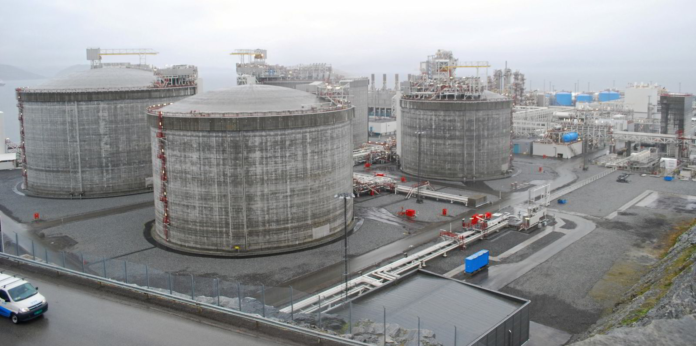- Scale derived from LNG investment is much higher, but profitability and payback periods make blue ammonia attractive
Blue ammonia, for our lay-readers, is made from nitrogen and “blue” hydrogen which is also derived from natural gas feedstocks, with the carbon dioxide by-product from hydrogen production captured and stored. And for the difference between ammonia and blue ammonia, low-carbon ammonia is ammonia because its CO2 emissions are usually reduced in the course of manufacturing, and classified either as “green” and or “blue ammonia,” depending however on the manufacturing process and the degree of reduction in CO2 emissions.
So the question for our attention as Europe moves away from Russian gas, and Asia reduces its dependency on coal, with demand and investment in liquefied natural gas (LNG) rising astronomically is, should gas resource holders target LNG exports or blue ammonia?
But according to “Stick or twist, a new Horizons report from Wood Mackenzie, the acceleration of the energy transition means gas resource holders increasingly face a choice – and that is either to follow consistently the established pathway and develop new LNG export facilities, or navigate into developing blue ammonia.
According to the report, “demand for LNG is expected to grow by just under 70% over the next 25 years to reach 700 metric tonnes per annum (mmtpa) by 2050. But neither growth nor revenue is locked in for LNG. As the energy transition gathers pace, gas stakeholders are questioning whether longer-term demand for LNG is so assured”, Giles Farrer, Head of Gas and LNG Asset Research and co-author of the report said.
Again, according to WM’s Accelerated Energy Transition (AET-1.5) scenario, the world needs far less new LNG supply; the market will still need 160 million mmtpa of new LNG supply to be developed by 2040, but beyond this time, developers face the risk of declining prices and underutilisation as demand reduces to 500 mmtpa by 2050 under the WM’s AET-1.5 scenario.
Faced with these challenges says Woods, holders of undeveloped gas resources have started to consider alternative ways by which they could monetize gas exports, and blue ammonia, already on the waiting list, to them, looks good for the plan. It is produced from low emission hydrogen, generated through gas reforming with carbon capture and combining it with air-sourced nitrogen, “has quickly risen to the top of the pile as a credible alternative to LNG for gas monetization.”
With the implementation of Europe’s Carbon Border Adjustment Mechanism (CBAM) the report indicated, ammonia prices are expected to increase by 60%, and low-carbon ammonia exports to Europe will become competitive against carbon-intensive alternatives.
“Momentum is building for blue ammonia. We see more and more projects – especially in the US Gulf Coast – looking to export blue ammonia to Europe and in many cases these are backed by major LNG players,” says Murray Douglas, head of hydrogen research at Woods, and co-author of the report.
In terms of size of the market, talking about the economics of LNG as blue ammonia, approximately US$250 billion of additional investment in pre-FID LNG liquefaction projects is required to meet Wood’s base case forecasts by 2050. This in contrast with US$24 billion of investment required for blue ammonia intended for exports. In Wood Mackenzie’s AET-1.5 case, the case for blue ammonia investment is much stronger, with US$80 billion required compared with US$160 billion for LNG.
“For those seeking scale over the next 15 years, the prize is still LNG rather than blue ammonia, but for profitability and value, blue ammonia could prove more attractive, although this of course depends on prices, costs and tax incentives”, Douglas said.
Adding that apples-with-apples comparisons are usually difficult due to different commercial structures and relative taxation, noting however that these differences could still be factored in to achieve some clear high-level conclusions:
The profitability and payback periods of blue ammonia investments could be much more attractive than LNG, report reveals, but this according to it will in part depend on location and incentives available, with the US 45Q tax credit improving competitiveness against markets with lower nominal feedgas costs. Offering an additional boost to blue hydrogen economics yet according to the report, is the pricing of carbon at the point of consumption.
Export-led projects will look first to markets like Europe offering incentives such as CBAM it says, but locking in European demand through long-term contracts could deliver internal rates of return for blue ammonia that are higher than those of LNG, halving payback periods.
Douglas stated: “Shorter payback periods for blue ammonia could be particularly attractive for those with first-mover advantage in accessing Europe. And if the world was going to edge closer to Wood Mackenzie’s AET-1.5 scenario, lower LNG prices and higher carbon prices would further strengthen the attractiveness of blue ammonia vs LNG.
As diversification into blue ammonia is a natural evolution for LNG developers and resource holders, developers now tend to deliver projects and supported gas-intensive industries, like grey ammonia, gas-to-liquid, methanol, aluminium, fertilizer exports, local power and so on, which means that blue ammonia can as well be viewed as further industrial diversification, with potentially better returns, according to report findings.
But blue ammonia is not without its challenges, findings also showed, because green ammonia, produced from electrolytic hydrogen powered by renewables, is overwhelmingly considered the future of low-carbon ammonia.
Says Douglas: “The window of opportunity is narrow. Blue ammonia will outcompete most green ammonia projects targeting FID this decade, but this gap closes beyond 2030 as the cost of renewable power and electrolysers continue to fall.”
For the two scenarios, Wood Mackenzie’s Accelerated Energy Transition (AET-1.5) scenario seems to only “aligns with the most ambitious goal of the Paris Agreement to limit temperature increases to 1.5 °C.”


